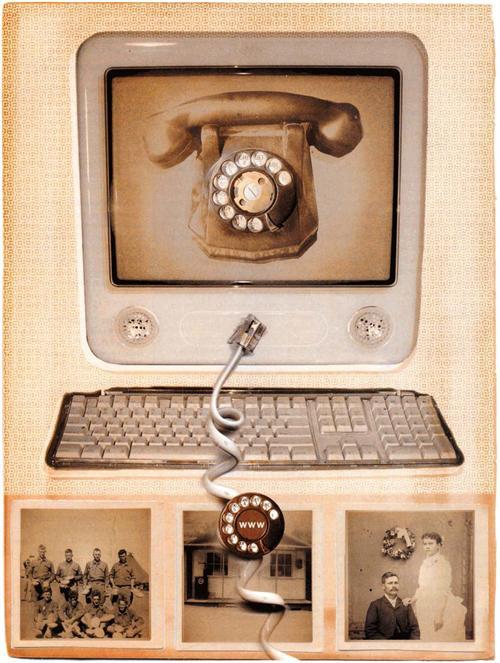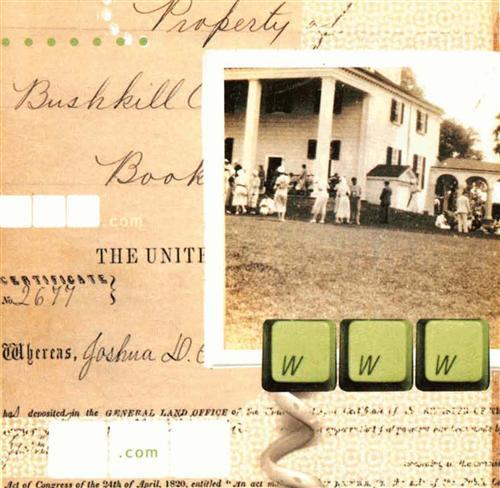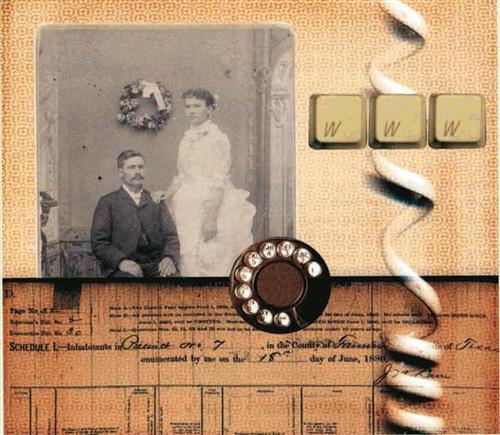
Scoping the data
When you visit one of the major genealogy-information Web sites, you will likely need to search its database for facts about your family, A database is a collection of information organized for quick searches and retrieval. Genealogy databases typically contain transcribed records or compiled family histories. For example, a marriage database might include the names of the bride and groom, the date and the town and county in which the ceremony was performed.
What you often won’t find are the “extras” that appear on microfilm of the actual record. These may include the names of the witnesses, minister or justice of the peace, and peripheral notes such as “performed at the home of the bride’s brother, Jonathan Sutton.”
Database-friendly documents contain basic “name-date-place” information — cemetery records (date and place, but not art carvings), immigration records, land records, marriage data and military rosters, for example.
What types of records aren’t database-friendly? Ones that contain text that doesn’t easily fit into a name, date or place field. These include medical records (type and length of illness, attending physician), military enlistment papers (soldier’s physical description, any notes by recruiting officer), pension files (which may contain description of military service, including specific battles and health of the ancestor), probate files (itemized property list, debts) and wills (detailed account of individual’s last wishes).
This doesn’t mean you won’t find a pension file online — someone might have transcribed and uploaded it to the Web. In fact, volunteers work daily to transcribe tombstone inscriptions, probate files, wills and even Bible records. But this kind of transcription is more likely to be sitting on a volunteer’s personal Web page than on a large, database-driven site. An exception, though, is USCenWeb <www.usgenweb.com>. Its county pages are maintained by volunteers, and anyone with Internet access can search them for free.
Let’s look at some of the most useful records you will find online, how to find them and how to get the most out of them.
Battling for military records
You’ve heard stories of Great-great-grandpa Joe’s stint in the Union Army during the Civil War. You may even be lucky enough to own his letters or wartime diary. Or perhaps family legend recounts how he survived a wound at Gettysburg and went on to take part in the Grand Review in Washington, DC, at the end of the war. Although family stories often “grow” with time, they usually contain a grain of truth. Wouldn’t it be great to find out more about Joe, including the regiment he served in and the battles be witnessed?
Your first step in researching such an ancestor should be a search for military rosters.
These are lists that tell the soldier’s name, rank, company and regiment — and many are online. For example, a search in the Illinois Civil War Veterans Database <www.library. sos.state.il. us/departments/archives/datcivil.html> for my great-great-grandfather Calvin Dimmitt returned a list of soldiers with the Dimmitt surname. Calvin was shown as serving in Company E of the 65th Illinois Infantry.
What the roster didn’t tell me was that he was captured at Antietam, was part of a prisoner exchange the following day, deserted, disappeared for a few years, ended up in Tennessee, rejoined the Union Army and married a local girl. But another database, Illinois Civil War Rosters from the Adjutant General’s Report <www.rootsweb.com/˜ ilcivilw/regros, htm>, revealed a bit more. I learned that the 65th Illinois was known as the Second Scorch Regiment or Cameron’s Highlanders, and that its soldiers signed up for three years of service. It showed the 65th was in service from May 1, 1862, to July 26,1865. It told me the regiment was filled with volunteers from Boone and McDonough counties. And it listed, under Company E, Calvin Dimmitt as a deserter.
A second type of online military record is a regimental history. This is a detailed account of a regiment’s activities from the day it was organized. Unless your ancestor was a commanding officer, it’s unlikely you’ll find his name in a regimental history. But you will learn which battles he was in, and when those battles were fought. An online search for the regimental history of the 65th Illinois found a summary of its activities from spring 1862 until July 13, 1865, when the unit was mustered out. The transcription <www. rootsweb.com/˜ilcivtlw/history/065.htm> describes the action where Calvin Dimmitt was captured:
The Regiment was ordered to Martinsburg, VA, and, on its arrival, was brigaded with the Hundred and Twenty-fifth New York and Battery M, Second Illinois Artillery, wider command of Colonel Miles. When Colonel Miles surrendered at Harper’s Ferry, the Sixty-fifth were made prisoners by the enemy. On the succeeding day, the Regiment was paroled and sent to Chicago, where it remained until April, 1863….
Today, you can find regimental histories for nearly every outfit. The Civil War Resources section of A Barrel of Genealogy Links <www. genealogytoday.com/barrel> includes links to most regimental histories on the Net.
No matter which war your ancestors served in, the Web can help you learn about the conflict and your ancestors’ experiences in it — certainly in a general sense, and perhaps even specific instances.
Finding battle descriptions of major Civil War engagements is easy; locating Revolutionary War ones is a bit more difficult. That said, I found a wonderful description of the 1780 South Carolina Battle of Hanging Rock — an action one of my ancestors described in his pension records. I even learned that the battle was observed by a 13-year-old president-to-be, Andrew Jackson, The battle description <www.inmyattic.com/lancaster/history/history_hangingrock.htm> said Jackson later modeled his own fighting style after the engagement at Hanging Rock.
Digging into cemetery records
We genealogists want to know every little tidbit about our ancestors’ lives, including their final resting places. I remember my exhilaration the day I finally discovered my third-great-grandfather’s burial site.
Thanks to volunteers, millions of names from cemeteries are being transcribed and uploaded to the Net. Again, you’ll find information that’s database-friendly, such as names, dates of birth and death, the location of the cemetery and possibly the burial-plot number. If your ancestor was buried in a military cemetery, rank and unit are often listed. What you likely won’t find in a searchable database are tombstone transcriptions, such as “beloved wife of,” a quote from a Bible verse or the artwork (which is often an important and overlooked clue).
 Searching for more clues
Searching for more cluesBut this is just the beginning of what’s online. If your ancestor lived in a public-land state and had a land grant, for example, you might hit pay dirt at the Bureau of Land Management’s Official Federal Land Patent Records Site <www.glorecords.blm.gov>.
Or consider census records, which you can find at such subscription sites as Ancestry.com <Ancestry.com > and Cenealogy.com<www.genealogy.com>. You also can find free census transcriptions via USCenWeb; see <www.us-census.org> and <www.roots web.com/˜census>.
Of course, genealogists don’t thrive on records alone. We are story weavers, and our family tapestries include whatever puts flesh and blood on the names in our pedigree files.
For instance, if you descend from a Revolutionary War veteran, wouldn’t it add interest to your family history book to include a firsthand account of battles he fought? Or a period map of the place he lived? Or descriptions of his family’s activities on the home front? How fascinating it would be to read his local newspaper or a popular book from that time. Luckily, you can find these types of items online — and most are free of charge. Here’s a sampling of what’s available:
Maps: The Library of Congress <memory.loc.gov/ammem/gmdhtml/gmdhome.html> holds more than 4.5 million maps, and a small percentage of them have been digitized and posted online. Typical maps include:
? an 1849 map of the California gold fields
? an 1862 pen-and-ink manuscript drawn on tracing cloth, showing the “line of Hooker’s advance,” roads, houses and names of their occupants, fences, vegetation, drainage
? an 1859 St. Louis city map
? an 1836 map of lands assigned to Indians west of Arkansas and Missouri
? a 1773 view of the “Potomack and James rivers in North America shewing their several communications with the navigable waters of the new province on the river Ohio”
? an 1893 map outlining the proposed route of the Tennessee, Alabama and Georgia railroad
Other Web sites contain maps of American migration routes, exploration trails, railroad routes, Indian territory, westward expansion, the Oregon Trail, territorial growth and military expeditions — plus street maps, historical city maps and county maps.
Maps will help you pin down where your ancestor lived. If you’ve “lost” a generation, migration maps can provide clues for possible places they may have stopped along the way. Look for more tips on finding and using old maps in the May 2003 Heritage Travel, a special issue of Family Tree Magazine.
Books: In 1995, the University of Michigan and Cornell University began a joint project to digitize hooks that document American social history from the antebellum period through Reconstruction. The collection, called Making of America <moa.umdl.umich.edu> and <library5.library.comell.edu/moa>, contains more than 3 million scanned book and journal pages. While you may not find a direct reference to your ancestors in these volumes, you will discover details about their daily lives.
I searched the collection for Lone Jack, Mo., the home of several of my ancestors. The search returned 12 hits. My favorite was a diary excerpt from June 9, 1858, in Beyond the Mississippi: From the Great River to the Great Ocean. Life and Adventure on the Prairies, Mountains, and Pacific Coast by Albert D. Richardson:
Beyond the Waukarusa we found one solitary “black-jack” (oak). In Missouri there is a flourishing town named Lone Jack from a tree of this species whose pleasant shade and a coot spring at its roots, made it a favorite camping-place for early travelers. At night, we sought refuge from a thunder storm in the hospitable log house of Ottawa Jones, a Pottawatomie half-breed, educated and bearing no appearance of Indian extraction. His white wife was a native of Maine. Both had been adopted into the Ottawa tribe, and he was chief of the band. For his Free State sympathies the Border Ruffians had burned his house, whose blackened ruins were standing a few yards from the present dwelling.
First-person narratives: During the Depression, the Works Projects Administration began interviewing average Americans and writing their life histories. The Library of Congress’ Federal Writers’ Project collection includes 2,900 documents representing the work of more than 300 writers <memory.loc.gov/ammem/wpaintro/wpahome.html>. This collection is searchable by keyword. The life histories contain stories of the Alaska gold rush and Oregon Trail, slave narratives and accounts of everyday life. You may not find your ancestors’ Oregon Trail story, but reading accounts from other travelers will offer insight into the conditions they faced on the 2,000-mile journey.

Another key online resource for historical documents is the Archival Research Catalog (ARC) <www.archives.gov/research_room/arc>, an online catalog of the National Archives and Records Administration’s nationwide holdings. You can perform keyword, digital-image and location searches, or do more advanced queries by organization, person or topic. (For a guide to ARC, see the April 2003 Family Tree Magazine.) Look for microfilm roll lists and descriptive pamphlets in the Microfilm Publications Catalog <www.archives.gov/research_room/alic/research_tools/search_microfilm_catalog.html>.
The Library of Virginia has a digital library program <www.lva.lib.va.us/dlp>, which includes an Index to Wills and Administrations, a searchable War of 1812 database, a marriage index and a land-records index.
These are among the other historical documents you can find online:
? A 1607 List of Jamestown Settlers <englishamerica.home.att.net/places/va607001.htm>
? An 1862 letter from General McClellan to President Lincoln <americancivilwar.com/documents/mcclellan_lincoln.html>
? Hessian Army life, 1776-1777 <www.hillsdale.edu/dept/History/War/America/Rev/1776-Hessian.htm>
? The Mayflower Compact <members.aol.com/calebj/compact.html>




